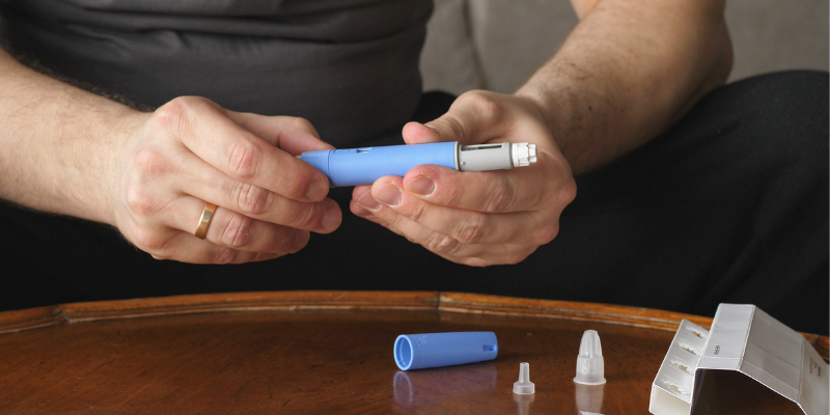Patient Grateful to Be Alive
- Category: News
- Posted On:

Holly Daugherty credits Patrick Cody, DO, Norman Regional emergency medicine physician, and Mehran Shahsavari, MD, internal medicine hospitalist, for saving her life almost one year ago.
Holly's Story
In January 2019, Daugherty began experiencing extreme nausea, dry heaving, light-headedness, and a “crushing pain” in her upper abdomen. She saw several doctors regarding her symptoms and had test after test done, but they all came back normal. Daugherty changed her diet and was put on acid reducer, smooth muscle relaxers, and ulcer medication, but nothing alleviated her symptoms and she began losing weight quickly.
Daugherty’s symptoms worsened over the next few months – She could no longer eat without pain, had lost 15 pounds, suffered from memory loss and hair loss, could not stand up without losing her vision due to low blood pressure, and had lost color in her skin. She was unable to work due to the extremity of her symptoms.
In June of 2019, Daugherty had her gallbladder removed.
“I was desperate to be well again so I took the opportunity,” Daugherty said. “I felt well for a few days afterward. My symptoms soon returned, however, and I was back to square one and feeling hopeless. I had now lost about 35 pounds and was terrified. Something was very, very wrong and nobody could help me. I was slowly dying and nobody knew it.”
On July 10, 2019, Daugherty began vomiting worse than ever and experiencing chills and a fever. When the vomiting ceased and she stood up to walk, her left leg went out from under her and she felt dizzy. The entire left side of her body was numb and tingly. Her boyfriend called 911 and she came to the Emergency Department. A stroke was ruled out, but she was found to have hyponatremia, hypochloremia, and an abnormal ECG. Her sodium and blood pressure were low, but they couldn’t find the cause and suggested it may be due to gastroenteritis. Once her sodium levels were brought up to normal the next day, she was released.
On July 26, 2019, Daugherty woke up and her left arm was numb so 911 was called again. Her sodium was taken back down to life-threatening levels and her blood pressure dipped even lower than usual. This time Dr. Cody was Daugherty’s doctor and ordered a cortisol check with labs.
“This simple test saved my life,” she said.
Daugherty stayed in Norman Regional’s ICU for a few days before being moved to PCU.
“I had never been more scared in my life, but the nurses were amazing,” she said. “I stayed for about a week while waiting for test results. The results suggested I had Addison's disease and I made the mistake of Googling it. My symptoms matched up perfectly and there was no doubt in my mind that it was the cause of my symptoms. I had a panic attack in my hospital room after that. I had never felt more alone and scared in my life. One of the nurses came to my room, coached my breathing to slow my heart rate, and helped me realize I was going to be okay. She asked if I wanted her to visit the next day. I thought she was joking but the next day she came in to visit me with her daughter. I couldn't believe she would use her time off to see me when she didn't even have to.”
What is Addison's Disease?
Addison’s disease, also known as adrenal insufficiency, is a condition in which the adrenal gland doesn’t make enough cortisol. It can cause a variety of symptoms, but most importantly makes it difficult for the body to regulate itself when under stress such as injury or infection, Dr. Cody said. Addison’s disease can occur in all age groups and in both sexes and can be life-threatening.
Some of the symptoms of Addison’s disease include:
- Extreme fatigue
- Weight loss and decreased appetite
- Darkening of the skin
- Low blood pressure
- Low blood sugar
- Nausea, diarrhea, or vomiting
- Abdominal pain
- Muscle or joint pains
- Irritability
- Depression or other behavioral symptoms
- Body hair loss or sexual dysfunction in women
“The treatment is relatively straightforward, but the diagnosis can be difficult to make because it can overlap with so many other things,” Dr. Cody said.
How is Holly Doing Now?
Almost a year since her hospital stay, Daugherty has regained the weight she lost, her skin has its color back, and she’s been back at work for eight months. She even got to meet up with Drs. Cody and Shahsavari to personally thank them.
“As an ER doctor, we rarely get to see or hear what happens to our patients once they leave our care. It’s always nice to hear back from a patient who had an excellent outcome,” Dr. Cody said. “When we get to save a life or make a difference in outcomes for a patient, it reinforces why most of us went into medicine. It’s definitely positive reinforcement to keep going in what can sometimes be a difficult profession.”
Daugherty will take steroids for the rest of her life. She said it’s a pain to have to take so many pills every day, wear a medical bracelet, and carry around an emergency injection, but in all the research she’s done, she’s amazed to be here at all.
“Addison's disease is extremely rare and it is insidious. The symptoms can be vague and mimic other health conditions until it's too late. Every single year, people die from undiagnosed Addison's disease. I am one of the lucky ones. Without that quick-thinking to check my cortisol levels I would not be here right now,” Daugherty said. “Having survived my ordeal against all odds, I am left with a sense of responsibility. Last month, I joined the National Adrenal Diseases Foundation as a volunteer. I am starting the Oklahoma National Adrenal Diseases Support Group. I hope to help prevent deaths from undiagnosed Addison's disease by raising awareness and improving the lives of people like me living with this disease. I feel indebted to all the doctors and nurses who helped save my life and made my stay there feel less lonely and less scary. Their caring attitude made a huge difference for me.”



